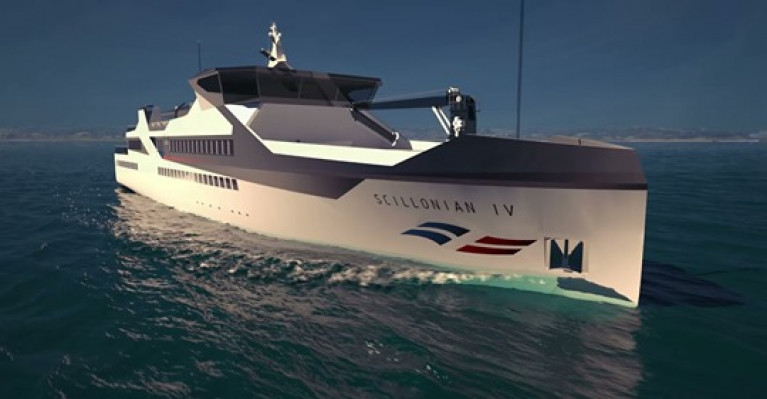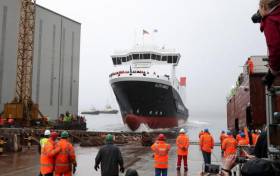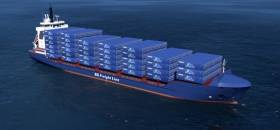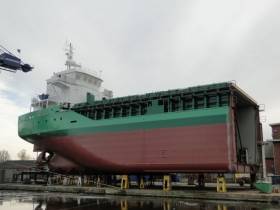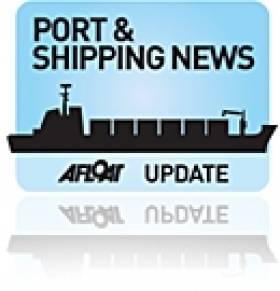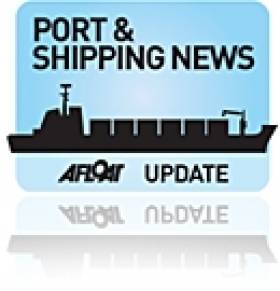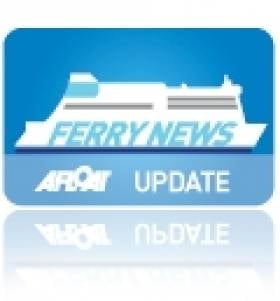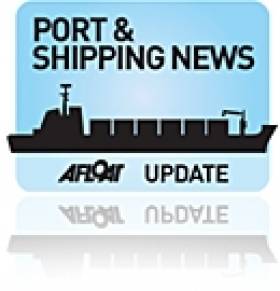Displaying items by tag: Newbuilds
Stena Line has announced that it is constructing two new bespoke freight ferries for Irish Sea service on its expanding Belfast-Heysham freight route.
The multi-million pound investment will significantly increase freight capacity on the route.
Each of the two new 147-meter vessels has been designed to maximise freight volumes and will provide 2,800 lane meters of capacity which is an 80% increase on current ship capacities.
The new vessels will be equipped to carry 12 passengers and 26 crew. The ‘NewMax’ vessels will be able to operate on methanol fuel.
Stena Line is currently working closely with the supply chain of methanol and has secured future volumes of e-methanol to fulfil its strategic ambition of shifting to renewable fuels and cutting 30% of its CO2 emissions by 2030.
Future proofing of the new vessels for electrification will also be another priority during construction providing in-built technologies that can take advantage of both battery propulsion and shore power, where this is available.
The unique tidal systems prevailing in Heysham can be challenging, so each vessel will be fitted with a bespoke marine technology configuration making it more resilient to the prevailing weather conditions. Three bow thrusters will provide optimum maneuverability and reliability and a specially designed engine/propeller configuration will further enhance berthing capability in extreme weather.
Paul Grant, Stena Line Trade Director said: “This is very significant day for Heysham-Belfast freight traffic. By adding an extra 80% capacity to the route, Stena Line has responded to growing demands from customers.
We have operated a very popular service on Heysham-Belfast for several years now but with restricted capacity it has been challenging to meet increased market growth. With the extra capacity, we will now be able to significantly enhance our service on this route and complement our Birkenhead, Cairnryan and Holyhead services.”
Phil Hall, Mersey Port Director at Peel Ports Group, said: “The Heysham-Belfast freight service is extremely important to the Port of Heysham. The construction of Stena Line’s two new ferries will go a long way towards meeting increased customer demand, while the additional capacity will allow for enhanced services for our port users. It’s a fantastic project to be supporting, and we look forward to delivering a bigger and better freight service for our customers from 2025 onwards.”
Stena Line is the largest ferry operator on the Irish Sea, with the biggest fleet offering the widest choice of routes including, combined passenger and freight services from Belfast to Cairnryan and Liverpool, Dublin to Holyhead, and Rosslare to Fishguard routes. As well as this dedicated freight only route from Belfast to Heysham, a total of up to 238 weekly sailing options between Ireland and Britain.
The ferry company also offers a direct service from Rosslare to Cherbourg and will be introducing an upgraded ship, Stena Vision, to this route for summer 2023, making this route the most frequent service from Ireland to France with 12 sailings per week.
Cornwall: Isles of Scilly Steamship Co. Reveal Designs for New Passenger Ferry & Cargoship
As Afloat previously reported, plans to replace the Isles of Scilly Steamship Company’s veteran Scillionian III, with designs for a new state-of-the-art passenger ferry and cargoship were recently revealed for the first time.
Currently the Scillonian III connects Penzance, Cornwall in south-west England to St. Mary's, the largest and most populous island of the archipelago. The vessel launched in 1977 from Appledore Shipbuilders in neighbouring Devon, operates the 2 hours 45 minutes island life-line link.
Following an extensive consultation process with the Isles of Scilly community, the striking new 72m passenger ferry (video) will carry 600 passengers over three decks with a contemporary, comfortable seating arrangement, an onboard coffee shop and retail area.
According to the Isles of Scilly Steamship, the newbuild will be capable of a speed of 18 knots, reducing journey time by 20%; anti-roll fins to improve the stability of the crossing; increased cargo capacity with the ability to carry chilled and frozen goods; improved access for passengers with reduced mobility. A hybrid propulsion system for the new passenger cargoship is to reduce emissions.
In addition a 45m dedicated cargo ship is to replace the Gry Maritha, will have an increased cargo capacity, including more space for chilled and frozen goods; a crane which can lift eight tonnes and a comfortable lounge for up to 12 passengers.
The new inter-island launch will be capable of 12 knots, allowing for significantly faster journey times between St Mary’s and the off-islands; a 50% increase in cargo capacity and will have a reduced fuel consumption of 55%.
The next step will be entering discussions with shipyards on potential build programmes. The company has partnered with international shipbroker Blair Reid, which specialises in the sale and procurement of new ferries.
Blair Reid is currently in contact with 32 shipyards across the UK, Europe and the Far East to acquire Expressions of Interest and to identify potential build slots and build cost.
Stuart Reid, Chief Executive said: “We have carried out an extensive consultation process and we have listened to what the Isles of Scilly community have identified as priorities in improving the service. Their needs have been at the forefront of the design process. We are proud of the proposals, which will ultimately enhance the excellent cargo and passenger services we operate today and serve generations of travellers for years to come.”
The design, in partnership with naval architects BMT, involved consultation with islanders and stakeholders last summer. It found resilience, reliability, journey time and affordability to be the most important factors for future services.
Ian Howard, Chairman said: “We have taken a major step towards the future with the finalisation of these designs. Now we must select the right yard(s) to build these vessels and secure finance for them.”
Kevin George, Director said: “Green technology is at the heart of the new designs; we aspire to minimise environmental impact at the earliest opportunity whilst ensuring the reliability and resilience of this vital lifeline service.
“In future, we want to have the ability to adapt and modify the chosen propulsion system to ensure we meet the Government’s target of decarbonisation of the marine sector by 2050 and to keep the vessels aligned with evolving environmentally friendly technology.”
Sylvain Julien, Director of Naval Architecture at BMT, said: “BMT is committed to leading the way in designing vessels that reduce the environmental footprint, and we welcome the opportunity to work in partnership with ISSG and the island community to work towards enhanced operations and increased sustainability by leveraging our deep understanding of advanced ferry designs.”
The Company is currently working with the Council of the Isles of Scilly and Government on financing options.
Shipyard in Scotland Urged to Pay for Delay to Two New CalMac Ferries
#FerryNews - A ferry firm state-owned by the Scottish Government has insisted it will not pay any extra cash for two new car-ferries being built to serve Scotland’s island communities, despite the work running over time and over budget.
As The Nationalist writes, Caledonian Maritime Assets Ltd (CMAL), which is responsible for buying and leasing ferries for operators CalMac, revealed it had known for more than 15 months that “things were not going to plan” with the construction of the vessels.
The Ferguson Marine shipyard in Port Glasgow won the £97 million contract to build the ferries – which will be the first in the world to run on a dual fuel system using both diesel and liquefied natural gas. For further reading on the newspapars story, click here.
First of the newbuilds, Afloats adds, named Glen Sannox following a competition was launched earlier this year at the Clydeside shipyard. The pair are designed to provide a fully flexible year-round service for the Ardrossan-Arran Island service and the Uig Triangle.
Earlier this year a new terminal on Arran was opened in advance of this summer. Sailings are served by Caledonian Isles and during the high-season support came from the veteran Isle of Arran (see Afloat’s ferry voyage report).
The CalMac route on the Firth of Clyde is the most southerly 'year-round' operated service.
#FerryNews - One of the two new Stena Line E-Flexer RoPax ferries bound for the Belfast–Liverpool route in 2020 has recently marked an important production milestone by celebrating its official keel-laying at the AVIC shipyard in Weihai, China.
The new RoPax vessels will have capacity for 1,000 passengers, 120 cars as well as 3,100 freight lane meters.
The newbuild pair be among the most energy efficient in the world with significantly lower CO2 emissions per freight unit against comparable RoPax tonnage. Paul Grant, Stena Line’s Trade Director (Irish Sea North) commented: “Everyone on the route is looking forward to welcoming the new generation of ferries to Belfast. We are delighted that two of the new fleet of E-Flexer ships will be entering service on our expanding Belfast – Liverpool route. It’s a real vote of confidence in the future development of our operations in the region.”
Paul Grant added: “The two new ships will be the biggest ships ever to operate on the Belfast – Liverpool service and will increase capacity for freight and travel customers as well as raising the service standards. Our onboard cabin concept will be enhanced to offer comfortable and relaxing day and overnight crossing options. The ships will be ‘drive-through’ making the loading and disembarkation processes faster and smoother for vehicles.”
#IrelandMax- Afloat has further researched into the names of BG Freight Line’s newbuilds lo-lo ships under construction in China and can reveal BG Emerald is among them, writes Jehan Ashmore.
The custom-built ‘Ireland’ Max containership with ‘green’ credentials is one of a quartet under construction at the Zhoushan Changhong International Shipyard in the city located near the Shanghai Yangshan Harbour. They are expected to enter service in 2018 on BG Freight Line’s short-sea Irish hub feeder services linking the UK, Belgium and the Netherlands.
Newbuild BG Emerald with a 1,004 TEU capacity will also enter the new and first ever Liverpool-Cork containeship service. The Merseyside-River Lee route was launched intially in March by Thea II, which appeared on 'Rivers with Jeremy Paxman'. The TV series broadcast earlier this year showed the presenter on board the 340 TEU boxboat when operating on the Manchester Ship Canal.
Afloat has also indentified the names to be given of the remaining quartet of sisters. They are BG Diamond, Jade and Sapphire.
Also ascertained is that each containership is around 11,000 gross tonnage and that they have been developed by BG Freight Line, in conjunction with designers CIMC ORIC and Arkon Shipping.
The ‘Ireland’ Max containerships are being built to DNV GL specification and fitted with state-of-the-art features in order to comply with Emission Control Area (ECA) requirements. This been a clear commitment by the operators to achieving the highest possible environmental standards.
Each of the quartet will be fitted with a modern wet scrubber system for exhaust cleaning in order to fulfil the requirements for trading within the ECA area. The vessels are also fully fitted for the loading of 45ft short-sea containers in all positions, with room in total for 488 units.
Additionally, a various number of odd-sized containers can be stowed fast and securely due to a new proprietary and innovative cargo stowage system. To minimise operational cost the vessel will be fitted with a modern two-stroke main engine with very low fuel consumption.
Specifications of the new 'Ireland' Max containerships
Containers: 1004 TEU (alternative 488 units 45ft)
Deadweight: 13,250 tonnes (on 8.0m draft)
Length overall: 153m
Reefer plugs: 253
Service Speed: 16 knots
Exhaust cleaning by WET-scrubber
As alluded BG Freight Line operate an extensive lo-lo container feeder network operated by 23 vessels among them BG Ireland. The additon of BG Emerald strenghtens the links of the nations served by the shipping line that is a subsidiary of the Peel Ports Group. They are a major operator of ports throughout the UK.
Irish Green and Dutch Orange Newbuilds Meet At Port of London
#ArklowThames - This week Afloat reported on stories from the Strait of Dover and it is on the other side of the Kent coast that a new ship, part of the Arklow Shipping fleet was until yesterday at anchorage, writes Jehan Ashmore.
The newbuild Arklow Valour (2017/5,158dwt) is the fifth completed ‘V’ class dry-cargoship.The vessel had anchored off Margate on the north Kent coast before sailing last night to the Port of London. Arklow Valour was within the first hour of this month moored alongside Conways Berth at Erith.
Arklow Valour is under the Dutch flag and is managed by Arklow Shipping Nederland B.V. based in Rotterdam. While upriver and opposite Tilbury Docks, a fleetmate but this time Irish flagged, Arklow Cadet (2016/5,085dwt) of Arklow Shipping Ltd was berthed at Bevans Wharf at Northfleet. The ship had sailed from Belfast Harbour.
Both newbuilds are 87m long and were allotted berths on the south bank by the Port of London Authority. The PLA are responsible for operations covering 95 miles of the River Thames. In addition to maintaining commercial and leisure users safe, the protection and enhancement of the environment and promotion of trade and travel.
Last month, Arklow Valour had been towed from the inland shipyard of Royal Bodewes at Hoogezand along the canal to Delfzijl to enter the sea. At Westerbroek which is nearby to Hoogezand is the German owned yard of Frus-Smit that completed Arklow Cadet last year. The vessel is the first in a series of ‘C’ class cargoships.
It is at Delfzijl, a port on the Ems Estuary, that by a series of coincidences there has been recent focus on Irish shipping news stories. In addition to that of recent years, notably given all the newbuilds ordered by Arklow Shipping that have been built in this region.
Also in the coverage of these newbuilds have been the ships entering to the sea for the first time to carry out sea trials. These trials are also conducted from Emeshaven (including Arklow Valour) which is located outside of the estuary on the North Sea.
As alluded in the introduction, the Strait of Dover, is where on Monday the bitumen tanker, Iver Ability (former long-stay Dublin Bay anchorage caller) transited the world’s busiest shipping channel. The 12,497dwt Iver Ability had departed Irish waters bound for Delfzijl, but as reported yesterday was and currently remains at anchorage in Dutch waters.
Also reported at Delfzijl is where Corrib Shipping Group are now providing ship management of the Ziltborg. The 7,200dwt general cargosship was renamed for Dutch based owners, Wagenborg.
Ziltborg remains at the port but in a floating drydock having undergone work including repainting of company colours. The Dublin based group expect the new addition to enter service within weeks.
Arklow Shipping Newbuilds from Dutch and South Korean Shipyards
#ArklowNewbuilds - Arklow Shipping's latest newbuilds are a general cargoship and bulk-carrier completed from Dutch and South Korean shipyards respectively and together they raise the fleet total to some 44 vessels, writes Jehan Ashmore.
Arklow Bank is understood to be the first of six 'B' class general cargoships ordered by ASL and was completed by Ferus Smit B.V. of Westerbroek in the Netherlands.
Notably, her design differs compared to her older counterparts in that she has a larger tonnage of 5,065 tonnes, an additional superstructure deck and hull design particularly the 'straight' stemmed and bulb-less bow.
This new hull form will give these new 'B' class vessels greater 'green' advantages as the longer and sharper waterlines reduce wave resistance even in rougher conditions, thus lessening impact irrespective of loading draft as deadweight of 4,800 tonnes allows to maximise cargo volume. The 119m long ship which is classed with Bureau Veritas has a two-hold grain capacity of 9902,6m³ and for bale of 349.706ft³ . Powerplant is a Mak engine delivering a maximum 13 knots.
She will join the company's Dutch division, Arklow Shipping Nederland B.V. based in Rotterdam, from where the newbuild takes that port of registry. This Dutch fleet forms a minority within the overall fleet that flies the Irish tricolour and registered aptly in the homeport and headquarters of the company located on the banks of the River Avoca.
Adding to the Arklow based fleet is the second newbuild, Arklow Spray which is a 'S' class 34,500 dwt tonnes bulk-carrier completed by Daesun Shipbuilding & Engineering of South Korea. Likewise this newbuild is also classed under Bureau Veritas.
Principle dimensions of the 22,868 gross tonnage Arklow Spray are length 182m, beam 30m and a draft of 10m. She easily surpasses both the companies 'W' and 'M' class of bulkers (see Arklow Mill as previously reported) in terms of overall dimensions.
Arklow Spray is the second of this new design following lead ship, Arklow Spirit which entered service last year. The pair each has five holds handling a grain capacity of almost 47,000m³ and for bale just shy of 45,000m³. Cargo-handling is served by 4 x 30t MacGregor Electric cranes. A main MAN engine plant delivers a maximum speed of about 14 knots based on a cargo-laden capacity.
The newbuild sisters continue to inherent the 'S' class vessel naming theme of a previous generation of much smaller Dutch built bulkers. Arklow Spirit became the last member of these ships to be sold off in recent years.
Dublin Based d’Amico Order Pair of Eco-Product Tankers
#TANKER NEWBUILDS – The Dublin based d'Amico Tankers Limited (Ireland), has entered into contracts for the construction of two additional new product/chemical tanker vessels.
Each of the 40,000 dwt handysize newbuilds, believed to cost US$ 30.65 million, are to be built by the Hyundai Mipo Dockyard Co. Ltd in South Korea. Delivery dates are expected early in 2014 and an option for two further vessels, under same terms and conditions, to be exercised by the end of this year.
The design of the newbuildings is double-hulled, flexible and IMO classed vessels, which belong to a new generation of vessels. Under a new concept the 'Shallowmax' vessels will have a lower fuel consumption/high efficiency and cubic/shallow-draft combination.
According to DIS, d'Amico Tankers Limited, have signed 'time-charter' agreements with one of the main oil majors for the newbuild pair for a period of five years. d'Amico Tankers Ltd control a fleet of 40 double-hull medium range (MR) and handysize product tankers. Following the latest newbuilds the fleet will increase to 24 owned vessels and 18 chartered vessels.
Seatruck's New Freight-Ferry on Delivery Voyage
#FERRY NEWS-Seatruck Progress (photo), the first of two 18,900 gross tonnes ro-ro newbuilds due to enter on Seatruck Ferries Dublin-Liverpool route, is en -route in the English Channel today from German builders, FGS Flensburg, writes Jehan Ashmore.
Her sister Seatruck Power is due to join her fleetmate on the central corridor service by mid-February. In addition Seatruck have on order another pair of the same class from FGS which are to be completed in 2012 and are likely to be deployed on the company's other Irish Sea routes.
The new quartet each measure 142m and will offer 2,166 lane freight-metres spread over four decks. They will each have a capacity of 150 units, 35 more than Seatruck's current P Series vessels in which Clipper Point and Clipper Pennant are currently employed on the route.
The company operate 80 sailings per week on four routes: Dublin-Liverpool,Dublin- Heysham, Warrenpoint-Heysham and Larne-Heysham. The newbuilds will also be the largest vessels ever to operate out of Heysham.
In the last two years freight volumes doubled and Seatruck has 20% of the Irish Sea market as against 3.7% in 2004. This year Seatruck will ship 300,000 units on the Irish Sea and with the fleet expansion this total will grow substantially in 2012.
Arklow's Asian Newbuilds
Arklow Shipping (ASL) has turned to the Sekwang Shipbuilding, South Korea for three general cargoships according to www.tradewinds.no
An order has been placed for three 14,200-dwt general cargoships at the yard for delivery from late 2012 to early 2013. The deal includes an option for an extra vessel. To read more click here.
Separate to the Asian newbuild programme is the 4,700 gross tonnes Arklow Bridge (click photo) the latest vessel completed for Arklow Shipping B.V. from the Dutch shipyard of Bodewes B.V.
The Co.Wicklow based company was established in 1966 and has a current fleet of over 40 vessels under the Irish, Dutch and Antiguan flags.


























